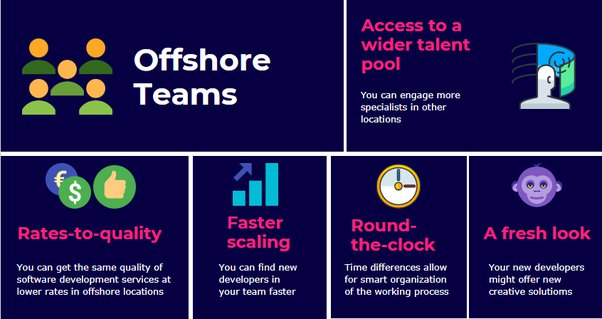In the winner-take-all digital economy, the top 20% of organizations in most industries control the returns and economic power. If you want to join the frontrunners, you need to get the right talent in the roles that matter. Problem is, human capital is scarcer than financial capital. Tech talent is even harder to pin down.
Many associations and leading organizations are employing remote tech workers and dedicated offshore teams to access a steady stream of elite talent. Others are even outsourcing the help desk and all IT work to an offshore team to conquer human-talent limitations and skills disruptions altogether.
With the right strategy and execution, a location-independent hiring pipeline can improve the quality of your talent pool and cut down expenses. The flexibility of outsourcing translates to less overhead, higher quality delivered services to members, and ultimately, a competitive edge in the long term.
This article walks through the pros and cons of a remote-work approach and how to employ remote tech workers and dedicated offshore teams with confidence.
Benefits of Remote Tech Workers & Offshore Teams
Not only are there direct cost benefits and an impressive opportunity cost outlook but also benefits around the quality, diversity, agility, and scalability of delivered services. All in all, hiring offshore teams for your IT projects makes you more effective and efficient in achieving your objectives.

Elite talent at better costs
Access to IT staff beyond a limited geographic radius around the traditional office “workplace” means a larger pool of skilled talent.
And in most cases, the cost to hire remote IT workers and help desk support is considerably less. Cost efficiency doesn’t mean cheap and of lower quality. Currency differences, economic factors, and purchase parity come into play.
Diversity of perspective and style
You also benefit from a diversity of viewpoints and insights. Engaging association IT workers and support teams from different backgrounds allows for finding unconventional solutions to everyday challenges and emerging member needs.

In fact, organizations with above-average diversity generate 45% more revenue from innovation. They innovate boldly, automate better, and deliver on strategy. And with greater innovation comes greater financial results.
Multicultural, multigenerational, and multigender teams can make internal and external decisions with greater agility. They may look at things from a different angle and contribute in ways you hadn’t considered.
This diversity of perspective and style can ultimately lead to better, cheaper, and more innovative solutions to tackle the technical side of digital culture (e.g. overhauling monolithic legacy systems, adopting automation, and embracing data and iterative ways of working to drive process efficiencies and value-driven continuous improvements).
Objectives and timelines
Remote IT workers and offshore teams, when properly vetted, provide a high control level, engagement, and flexibility. Typically, this translates to timely project delivery, especially when you work together to plan out deadlines and objectives.
Remote workers and outsourced IT support teams can work round the clock, approaching changing circumstances with increased flexibility, accuracy, and speed. Meanwhile, you can focus on what matters to your association.

Dedicated tech support
Dedicated offshore development teams and end-to-end help desk support are much different from outsourcing to a consultant or freelance IT worker.
In dedicated offshoring or dedicated talent partnerships, IT specialists, developers, and support technicians are hand-picked for your business to fill the skill gap, extend your in-house IT team, or work on different projects.
Put simply, hiring remote tech workers and offshore teams puts you in a better position to compete with the money-makers. You get integrated, scalable IT support focused on your goal and invested in your culture and success.
However, nothing of worth comes without inherent challenges. Adopting a remote-first IT strategy is not a universal pill. There are some kinks to iron out.
Challenges of Hiring Remote Tech Workers & Offshore Teams
Geographic dispersion and remote working arrangements raise obvious questions around sourcing, vetting, onboarding, compliance, and management limitations. Here are the main concerns:

How can I find remote IT fill-ins with a background in the association industry?
You want IT workers who can solve daily association IT issues around disconnected systems, data silos, and accumulated technical debt that be hurting your member experiences and change initiatives.
Where can I find a fully dedicated IT team with association tech expertise?
If you don’t know where to look, it can be daunting to find a qualified, flexible, fully dedicated offshore tech team or a strategic partnership to access elite remote tech talent with industry know-how.
You don’t want to get locked into something but you also don’t want to start down the wrong path and accumulate even more technical debt.
Onboarding and training
Searching, onboarding, training, and time for immersion take a lot of time, especially if you go with remote tech support without any association experience.
There are no guarantees. To avoid risks, you need to vet properly, go with an industry partnership, and aim for dedicated IT staff or a full-on team. To ensure that you receive a dedicated offshore development team and/or remote IT workers, you need to work with a trustworthy partner.
Look for an industry partner who can handle the assembly of an incredible team of remote tech workers, organize the working process, and integrate your remote IT team into the activities of your onsite office using a flexible, easy-to-start model.
The alliance should free you up to focus on value-added initiatives rather than talent acquisition, deployment, upskilling, and training.
The complexity of scaling
The cooperation between remote IT workers and offshore teams is often based on mutual trust. Freelancers and third-party consultants might just up and abandon projects or move to a better-paying gig.
But the right outsourcing vendor should allow you to scale your IT support up and down as your needs change. With this kind of resource efficiency and flexibility in your IT department, you can stay at the forefront of innovation regardless of your financial and human resources.
Cultural gaps and communication dilemmas
Good communication and vetting are key! You cannot afford cultural misalignment and communication breakdowns in the ever-changing world of digital business. For the communication side of things, technologies like videoconferencing and task trackers allow for flawless workflows.

But the digital cultural fit is a whole other feat. Hiring a dedicated outsourcing vendor in the industry is critical to eliminate culture concerns and ensure you IT workers who are immersed in your workplace culture with a clear sense of direction, accountabilities, and informed decision making.
You need an IT talent that embraces an entrepreneurial, collaborative, and agile way of thinking in the rapidly modernizing workplace. But at the same time, you don’t want to get caught up in hiring hassles, attrition losses, training issues, and the potential for culture misalignment and inefficient communications.
How Do I Hire & Manage Remote IT Support?
Agile workforce models are making headway as a cost-effective alternative to third-party consulting or expensive full-time, in-house IT teams. The idea is to let go of rigid hierarchies and directive, ready-made team structures.

It is all about maintaining a long-term partnership of value, cooperation, and cultural alignment, not just cost minimization or time-to-delivery but rather end-to-end delivery of value. This is only possible when you create IT teams that have the skills, processes, and accountability for business outcomes.
Elastik Teams, for example, is the association partner for remote tech support. Our highly flexible IT staffing model blends tech rockstars from across the globe with people in your area into an adjustable, dedicated IT team committed to your team and a part of your culture.
This kind of tech support planning is becoming indispensable to add to your association’s IT staffing toolbox as it gives you the capacity and discipline when and how you need it, ensuring you can react dynamically on the spot or forecast capacity needs in the future.
If you are an association or nonprofit looking to build flexible teams of top tech talent in the association industry, let’s talk!

Flow-to-Work Tech Support from Elastik Teams
Our “flow-to-work” approach to talent allocation at Elastik Team is about linking human capital to intended output. We connect associations, nonprofits, and socially driven organizations with remote tech workers or a dedicated offshore team with the best-match skills to fill immediate needs. It’s about keeping your nimble and opportunistic.
Access critical human capital to manage IT staffing shortages, navigate the unexpected, and move your teams around or even cut roles completely without throwing off your strategic outlook. Our next-gen staffing augmentation paradigm allows you to run profitably, adapt continuously, and grow sustainably.
With decades in the association industry, we understand the skills you need and can get you the right tech talent. Flexibility, agility, and people development reign supreme in our “flow-to-work” approach to talent allocation, allowing for rapid responsiveness and the freedom to plug in talent and adjust you go.
From there, your dedicated IT teams will work with you to connect the data, processes, and technology to inform strategy, build insights, and drive the needle forward through coherent decision-making.
Want us to start molding you a remote tech support team? Connect with us to get access to an adjustable team of elite remote tech workers to help with everything from AMS support and maintenance, system integration, website UI work, database maintenance, and much more!



